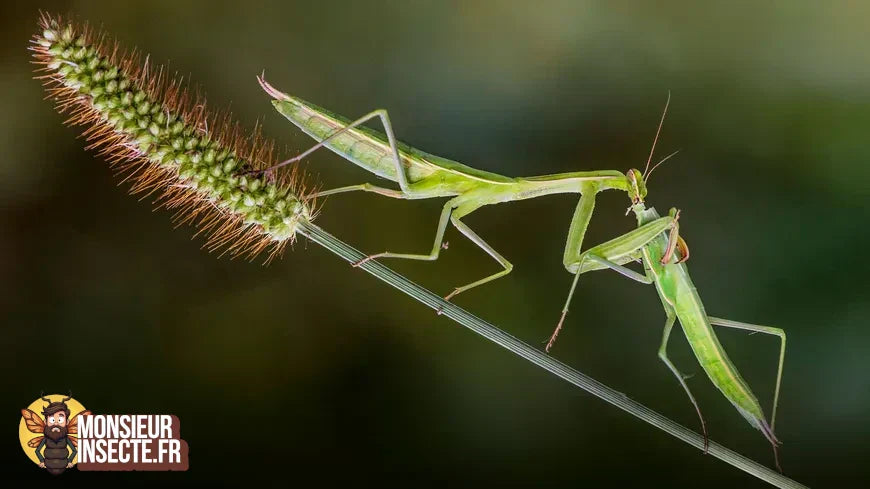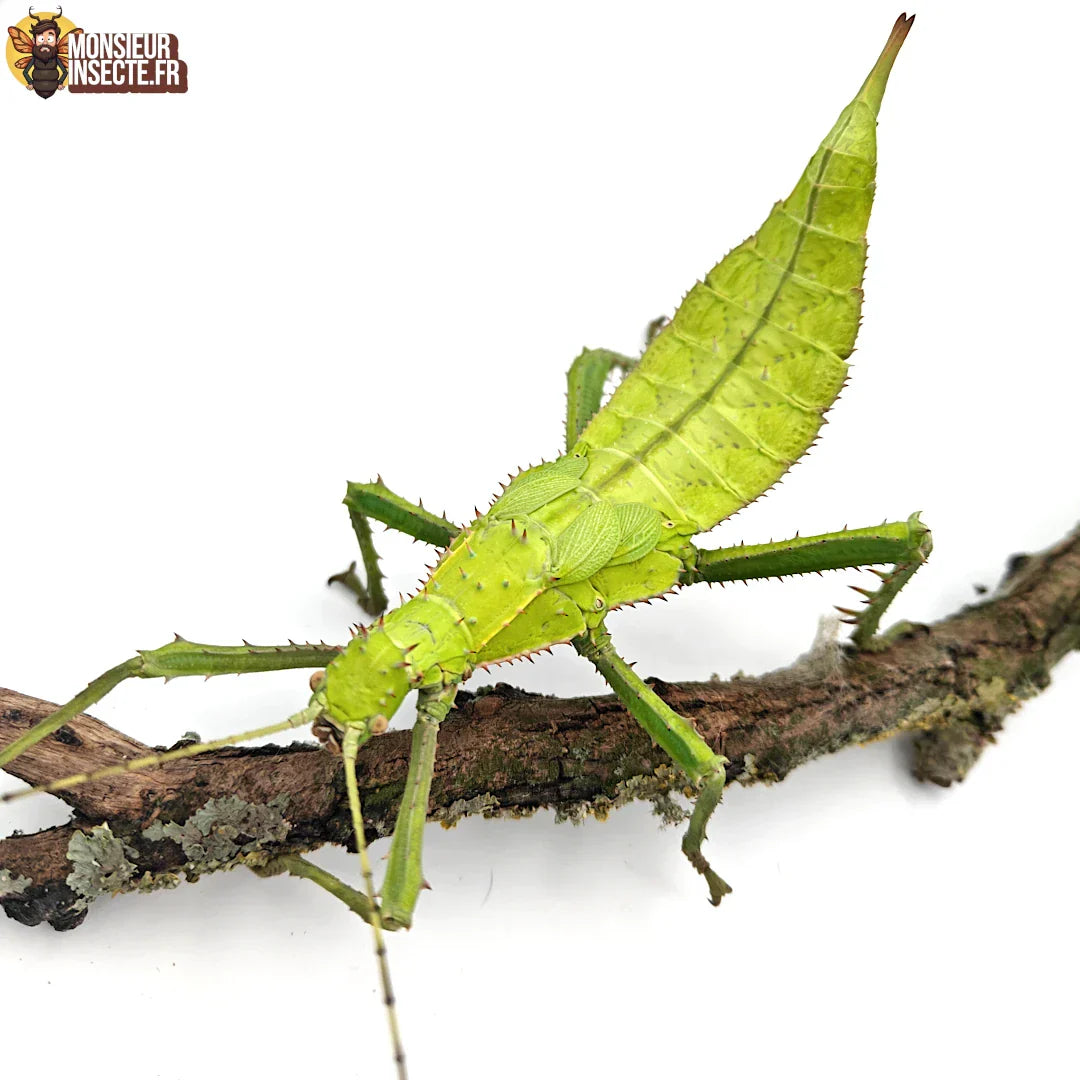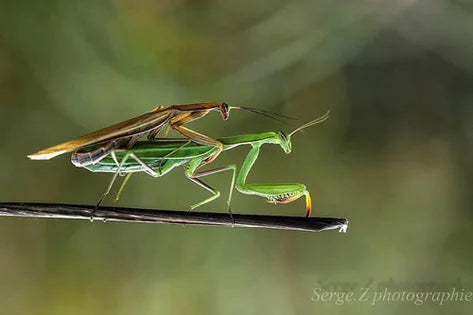How the praying mantis kills the male: a fascinating phenomenon of nature

The praying mantis ( Mantis religiosa ), a fascinating arthropod , is known for its unique and often fatal mating behavior for the male . This phenomenon of sexual cannibalism intrigues entomologists and raises many questions about the evolution and reproduction of this insect species .
But BE CAREFUL: It is far from being that common, some species like Sibylla Pretiosa can live very well in groups as long as they are well fed. We discuss it:
Anatomy and predatory behavior of the praying mantis
Morphology and adaptation
The praying mantis is a carnivorous insect with a morphology perfectly adapted to hunting and capturing prey . Its body is divided into three parts : the head capsule , the thorax and the abdomen . It has compound eyes , capable of detecting the slightest movement, and antennae that play a crucial sensory role. Its forelegs , formidable capture tools, are armed with sharp spines allowing it to firmly hold its prey .

Mantises are opportunistic predators that feed on various orthopterans , such as grasshoppers , locusts , but also beetles , hymenopterans , lepidopterans , spiders , and even small vertebrates such as reptiles and amphibians under certain conditions. Their varied diet makes them useful in biological control , helping to regulate pest insect populations .
But then WHY?
Sexual cannibalism: why does the female devour the male?
Sexual cannibalism in praying mantis is a well-documented behavior, although it varies depending on the circumstances. It is a process where the female , often larger and more robust than the male , devours him during or after mating . In fact, many laypeople are unaware of this, but in nature, the female regularly eats her male DURING mating.
Factors influencing sexual cannibalism
- Female Nutrition and Survival : Female praying mantises have an increased energy requirement to lay their eggs . By consuming the male , they acquire an optimal nutritional intake, thus promoting the production of viable eggs .
- Stress and proximity : When the female is hungry or in a resource- poor environment , the likelihood of sexual cannibalism increases. A male who is too close or too clumsy may be mistaken for prey .
- Evolutionary strategy : Some entomology researchers suggest that sexual cannibalism may be an adaptive advantage, increasing the chances of offspring survival .
- Species influence : Not all mantis species practice sexual cannibalism . Some, particularly in tropical regions , exhibit lower rates of this behavior.
Even though it seems incredibly cruel, sexual cannibalism is actually good for the male. It's not certain that he'll be happy about it at the time, but in reality, and by opening your understanding, you'll understand that sexual cannibalism is an opportunity for the male to strengthen his offspring and therefore increase his chances of passing on his genes. Which is the sole purpose of a male insect's life.
Insects don't experience pleasure, joy, or love. Their feelings are limited to reflexes like hunger, fear, stress, and the compelling need to reproduce. For a long time, it was thought that insects couldn't feel pain. Today, and although the issue is still debated, recent studies seem to demonstrate that a large part of the kingdom feels at least discomfort instead of pain. Which is ultimately a form of pain.
The process of sexual cannibalism
- Male Approach : To mate, the male must approach the female cautiously. He often displays courtship behavior , using his jointed legs and antennae to try to calm the female.
- Mating : The male climbs onto the female 's back and uses his copulatory organ to fertilize her eggs. During this act, the female may begin biting his head capsule .

- Decephalization (or like to say DECAPITATION 😁) : If the female attacks the male , she generally starts with the head , which contains the inhibitory nerve centers. This curious mechanism means that the male continues to mate even after losing his head , since his abdominal nervous system takes over. It's very practical 😎.
- Male Consumption : Once mating is complete, the female often devours the rest of the male 's body , including his hind legs and abdomen . The female 's powerful mouthparts allow for rapid ingestion.
Biological and evolutionary impacts
Benefits for the female
- Increased reproductive success through protein intake .
- Access to essential nutrients for developing and laying eggs. Indeed, laying several oothecae, sometimes up to 5 or 6, requires a huge amount of calories.
Consequences for the male
- The death of the male may seem like a disadvantage , but it favors the transmission of his genetic material .
- Some males adopt strategies that avoid cannibalism , such as rapid fertilization, nuptial offerings , or for the most ferocious, pure and simple physical aggression of the female aimed at injuring her enough so that she no longer presents a risk to them. Note that one could draw a parallel, admittedly a little hasty but comical, between this violent mode of reproduction and that of sharks that sometimes bite their female until she dies. Merciless nature.
These images are extremely hard to find, so please forgive the poor quality. 
Conclusion
Sexual cannibalism in praying mantis is a fascinating example of an adaptive strategy . Although brutal, this behavior is primarily an evolutionary tactic promoting the survival of the species . While it is extremely shocking to our human perception, it is also a gateway to a world that does not operate by the same rules at all.
A world where cruelty and love do not exist: only the survival of the species matters.
Aymeric




Leave a comment
This site is protected by hCaptcha and the hCaptcha Privacy Policy and Terms of Service apply.